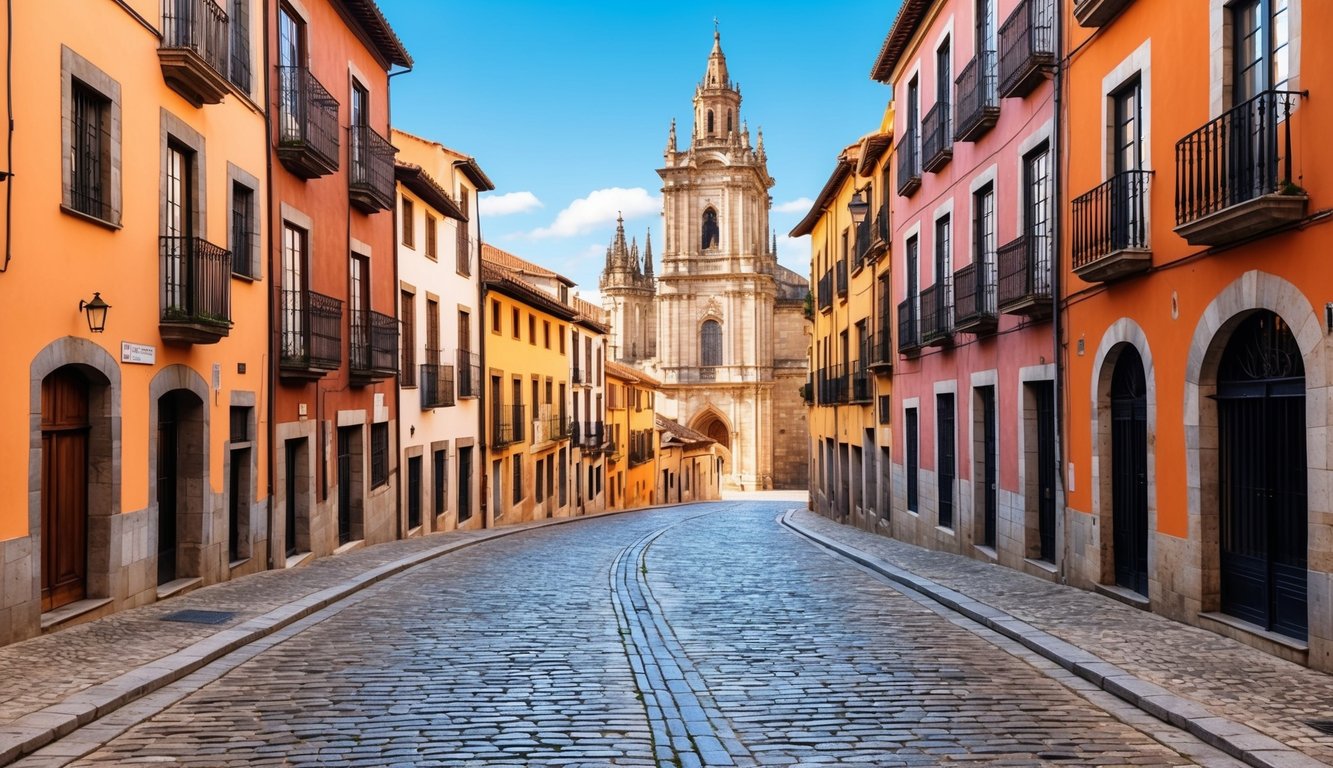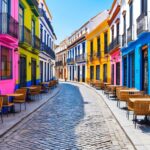Santiago de Compostela, located in the lush region of Galicia, Spain, is a city filled with history and culture. The magnificent cathedral, a UNESCO World Heritage Site, attracts thousands of pilgrims and tourists each year. As you stroll through the cobblestone streets, you’ll discover rich traditions, vibrant local life, and stunning architecture that tell the story of this ancient city.
You might also hear about the famous Camino de Santiago, a pilgrimage route that has drawn travelers for centuries. Each year, people from all walks of life embark on this journey, seeking both a spiritual experience and a chance to connect with the breathtaking natural landscapes that surround the city. Santiago de Compostela is not just a place; it’s an experience that merges history, culture, and the joy of exploration.
Whether you’re interested in the local gastronomy, historical sites, or simply soaking up the atmosphere, Santiago de Compostela has something for everyone. You’ll leave inspired and enriched by what this remarkable city has to offer.
Key Takeaways
- Santiago de Compostela is famous for its impressive cathedral and rich history.
- The Camino de Santiago attracts travelers seeking adventure and spiritual growth.
- The city offers a mix of culture, local traditions, and beautiful landscapes.
Historical Significance

Santiago de Compostela is rich in history, especially as a major pilgrimage site. This city has a deep connection to the Catholic tradition and a fascinating medieval past that shaped its identity.
The Catholic Tradition
At the heart of Santiago de Compostela is the tomb of Saint James the Great, one of Jesus’ apostles. This site became a vital destination for pilgrimage, drawing visitors for centuries. The Camino de Santiago, or the Way of St. James, is the pilgrimage route leading to the city, encouraging spiritual growth and connection.
The Cathedral of Santiago is a stunning example of Romanesque, Gothic, and Baroque architecture. It houses the remains of the saint, making it a sacred space. The famous Codex Calixtinus, an important medieval manuscript, promotes this pilgrimage, detailing its benefits and significance in promoting faith across Europe.
Medieval History of Santiago
In medieval times, Santiago de Compostela emerged as an important city in the Kingdom of Galicia. The discovery of Saint James’ tomb in the 9th century turned it into a hub for Christian pilgrims. The city prospered, connecting cultures through trade and faith.
Santiago became one of the main pilgrimage sites alongside Jerusalem and Rome. The architecture seen today reflects this history, with many buildings dating back to the medieval period. As pilgrims made their journey, they shaped the culture and stories of the city, leaving a lasting impact that echoes in its streets today.
Cultural Heritage
Santiago de Compostela is rich in cultural heritage, shaped by its unique history and traditions. The elements of Galician culture, language, literature, and music define the essence of this historic city.
Galician Culture
Galician culture is vibrant and distinct, influenced by its Celtic roots and the Mediterranean. You’ll notice this in the local festivals, music, and art. Traditional dances like the muiñeira and joro celebrate joy and community.
Food plays a huge role too. Dishes like pulpo a la gallega (octopus) and empanada showcase local flavors. The Cathedral of Santiago, a UNESCO World Heritage Site, is not just an architectural marvel; it stands as a symbol of Galician identity and devotion.
Language and Literature
The Galician language is an essential part of the region’s identity. Spoken by many locals, it’s celebrated in literature and poetry. Famous writer Rosalía de Castro is a key figure, known for her works that express Galician pride and culture.
You can explore literature through local bookstores, where you’ll find books in both Galician and Spanish. Enjoy poetry readings or performances that highlight the rich literary tradition. From music to literature, the Galician language brings people together and plays a vital role in the cultural scene.
City Landmarks
Santiago de Compostela is packed with incredible landmarks that showcase its rich history and culture. From the stunning Cathedral to the charming streets of the Old Town, there’s so much to explore.
Cathedral and its Surroundings
At the heart of Santiago de Compostela, the Cathedral of Santiago is a breathtaking sight. Known as the Catedral de Santiago de Compostela, it attracts thousands of pilgrims and visitors each year. Construction started in 1075, blending styles like Romanesque, Gothic, and Baroque.
The Plaza del Obradoiro is right in front of the Cathedral, a perfect spot to soak in the atmosphere. Here, you can appreciate the impressive facades and take photos with fellow travelers. Don’t miss the Botafumeiro, a giant incense burner that swings during special masses.
Just a short walk away, the Monastery of San Martiño Pinario offers a glimpse into the city’s monastic history with its exquisite baroque architecture.
Historic Center
The Old Town of Santiago de Compostela is a UNESCO World Heritage Site, full of narrow streets and lively squares. You can wander through its historic alleys, where every corner reveals something special.
As you stroll, you’ll see buildings dating back to the Middle Ages. Old stone walls and quaint shops give this area a unique charm.
Make sure to visit Casa do Cabildo, showcasing stunning architecture and a great spot for a coffee. Each square you encounter, like the quaint Plaza de la Inmaculada, invites you to pause and enjoy the vibrant street life.
Museums and Cultural Spaces
Santiago is also home to several notable museums that enrich its cultural landscape. The Museo das Peregrinacións dives into the history of the Camino de Santiago, highlighting the pilgrimage’s significance.
You’ll find artifacts and art that tell stories of those who journeyed to this sacred site.
Another gem is the Museo do Pobo Galego. This museum focuses on the culture of Galicia, showcasing traditional crafts, costumes, and more.
Visiting these spaces gives you a deeper understanding of both Santiago and its people. Each museum captures the essence of this remarkable city.
The Camino de Santiago
The Camino de Santiago is a famous pilgrimage that brings people from all walks of life to the stunning city of Santiago de Compostela. With various routes leading through beautiful landscapes and rich history, this journey is truly unique.
Routes and Traditions
The Camino de Santiago offers several routes, each with distinct experiences. The most popular route is the Camino Francés, which starts in St. Jean Pied de Port, France. It stretches about 780 kilometers across northern Spain.
Along your journey, you’ll encounter the iconic scallop shell, a symbol of the pilgrimage. Many pilgrims wear it as a marker of their journey.
Traditionally, pilgrims collect stamps in a Pilgrim’s Passport from various locations along the way. Collecting these stamps is a fun way to document your travels. When you complete the pilgrimage, you can receive the Compostela, a certificate of completion.
Modern Pilgrimage
Today, the Camino de Santiago attracts thousands of modern pilgrims and hikers. Some walk for spiritual reasons, while others explore its cultural and historical significance.
You’ll find well-maintained paths, cozy albergues (hostels), and welcoming locals. Many enjoy meeting fellow travelers and sharing stories around the dinner table.
Fitness levels vary among pilgrims. Whether you’re looking for a challenging hike or just a leisurely stroll, there’s a route for you. Local festivals and events also add to the festive atmosphere along the way.
Architecture
The architecture of Santiago de Compostela is a stunning mix of styles that reflects its rich history. You will find important elements from Romanesque, Gothic, and Baroque designs that together create a unique experience for visitors.
Romanesque Structures
The Catedral de Santiago is a prime example of Romanesque architecture. Construction began in the 11th century and features thick walls, round arches, and sturdy columns. The overall layout is impressive, with a cruciform shape that enhances its grandeur.
One highlight is the famous west façade, where you can see intricate sculptures and reliefs. This façade, along with the Plateresque cloister, showcases ornate designs typical of this period. Key elements like the barrel vaults and large, semi-circular windows also add to the building’s majestic feel.
Gothic Influence
As you walk through the cathedral, notice the Gothic influences that emerged later. During the 13th century, enhancements transformed the original Romanesque style. This period added pointed arches, ribbed vaulting, and flying buttresses.
The nave is particularly striking, with its tall ceilings that create a sense of expansiveness. You may also observe beautiful stained glass windows letting in vibrant light. These features contribute to the cathedral’s elegant and divine atmosphere, making it a significant pilgrimage site.
Baroque Features
The Baroque period brought even more beauty to the Catedral de Santiago. The stunning Baroque façade, completed in the 18th century, is adorned with elaborate sculptures and details. This final touch creates a sense of movement and drama.
Nearby, the Hostal dos Reis Católicos echoes Baroque design with its impressive façade and elegant interiors. You’ll appreciate the blend of hospitality and history in this beautifully preserved building. The grand staircases and detailed carvings make it a wonderful place to stay while visiting the area.
Local Life and Traditions

In Santiago de Compostela, local life is vibrant and full of rich traditions. The city’s unique cuisine and lively festivities reflect its cultural heritage. You’ll find flavors that excite your taste buds and celebrations that bring the community together.
Cuisine
When it comes to food, Santiago has a lot to offer. Seafood is a big deal here, thanks to the nearby Atlantic Ocean. One must-try dish is Pulpo a la Gallega, which is octopus served with potatoes and sprinkled with paprika.
Tapas are another favorite, allowing you to enjoy small bites of various dishes. You might find corn fritters or grilled seafood among the choices. Pair your meal with a glass of Albariño, a refreshing white wine that complements the local flavors perfectly.
Festivities
Festivals in Santiago are numerous and lively. Most famous is the Feast of St. James in July, celebrating the city’s patron saint. Expect parades, music, and lots of food.
In addition, Carnival is another exciting time when locals dress up and enjoy street parties. These festivities include dances and traditional music, making it an excellent time to experience local culture.
Don’t miss the fun nightlife either. Tapas bars and pubs buzz with activity, offering a chance to mingle with locals and other travelers.
Natural Landscapes

Santiago de Compostela is surrounded by stunning natural landscapes that highlight the beauty of Galicia. The region features majestic mountains, flowing rivers, and a climate that supports lush greenery. Here’s a closer look at the geography and climate of this unique area.
Geography
Santiago de Compostela sits in the northwest of Spain, nestled in the Galician region. This area is known for its rolling hills and mountainous terrain.
Key Geographic Features:
- Mountains: The nearby Sierra de Outes offers a picturesque backdrop.
- Rivers: The Ulla River winds through the landscape, providing beautiful views and opportunities for outdoor activities.
- Proximity to the Atlantic Ocean: Just a short drive away, the coast features dramatic cliffs and serene beaches.
The varied geography creates diverse habitats and makes the city a great spot for nature lovers.
Climate and Weather
The climate in Santiago de Compostela is classified as oceanic. This means you can expect mild winters and cool summers, along with regular rainfall.
Climate Facts:
- Precipitation: Rainfall occurs throughout the year, with the heaviest months usually in autumn and winter.
- Average Temperatures: Summers typically range from 20°C to 25°C (68°F to 77°F), while winters can drop to around 5°C (41°F).
The consistent moisture from the Atlantic Ocean supports lush vegetation, making the area’s landscapes vibrant and green. Whether you’re hiking in the mountains or strolling along the rivers, the natural beauty is truly captivating.
Economy and Infrastructure

Santiago de Compostela has a vibrant local economy driven by agriculture, tourism, and services. The city’s infrastructure supports these sectors effectively, connecting you to major regions in Spain.
Local Economy
The local economy is diverse, largely rooted in agriculture. You will find fruits, vegetables, and dairy products thriving in the surrounding areas. Timber from Galicia also plays a key role, thanks to the region’s lush forests.
Fishing is another significant industry, with fresh seafood making its way to local markets and restaurants. The Mercado de Abastos is a must-visit for anyone wanting to sample local produce and seafood.
Tourism has exploded, especially due to the Camino de Santiago pilgrimage. Travelers from places like A Coruña, Barcelona, and Madrid flock to the city, boosting hospitality and service businesses.
Transportation Networks
Santiago de Compostela is well-connected by various transportation options to make your travel smooth. The city’s bus network offers routes to nearby cities like A Coruña and even extends to major hubs such as Madrid and Barcelona.
For air travel, Santiago Airport serves both domestic and international flights, making it easy to travel to and from the city. Additionally, the city’s roadways are designed for efficient travel, accommodating tourism and local traffic alike.
Rail connections are robust, with services linking Santiago to other key Spanish cities. This means you can explore more of Spain without a hassle.
Contemporary Santiago
Santiago de Compostela is a lively city that blends education, modern architecture, and urban expansion. You’ll find many exciting developments and institutions reshaping its landscape.
Education
Education plays a vital role in Santiago. The city is home to the prestigious University of Santiago de Compostela, which attracts students from around the world. This historic university enhances the city’s cultural richness.
The university offers numerous programs across various fields, and its vibrant student life contributes to the city’s dynamic atmosphere.
Additionally, there are many other educational institutions, including art schools and vocational training centers. These schools not only focus on traditional academics but also emphasize the arts and modern disciplines.
Modern Developments
Modern developments in Santiago are prominently showcased at the Cidade da Cultura de Galicia. This cultural complex encourages arts and education, making it a hub for creativity. You can explore exhibitions, attend concerts, or enjoy the stunning architecture designed by Peter Eisenman.
Urban expansion has also shaped the city. New neighborhoods are emerging, making room for more residents and businesses. This growth supports the local economy and offers various amenities.
With initiatives from local leaders and the Autonomous Community of Galicia, Santiago is evolving while still maintaining its historical charm. You’ll see a perfect blend of the old and new as you walk through the streets.
Frequently Asked Questions

Santiago de Compostela is a city full of history and culture. If you’re planning to visit, you might have some questions about what to expect, the pilgrimage, and why this place is special.
What can you do in Santiago de Compostela?
There are plenty of activities to enjoy in the city. You can visit the breathtaking Cathedral, explore the vibrant local markets, and enjoy delicious Galician cuisine. Don’t forget to stroll through the charming streets of the old town, which is a UNESCO World Heritage site.
How long is the Camino de Santiago pilgrimage?
The length of the Camino varies by route. Most popular paths take around 30 to 35 days to complete, starting from locations like Saint-Jean-Pied-de-Port in France. If you’re short on time, you can join shorter sections or even day hikes to experience part of this famous pilgrimage.
What makes Santiago de Compostela a significant site for Christians?
Santiago de Compostela is believed to be the burial site of Saint James, one of Jesus’ apostles. For centuries, pilgrims have traveled to this city for spiritual growth and to honor his legacy. This pilgrimage is a key part of Christian tradition.
Why is Santiago de Compostela a popular tourist destination?
People are drawn to Santiago for its rich history and stunning architecture. Its mix of ancient streets, cultural events, and delicious food makes it a vibrant destination. Also, the Camino experience attracts many who are seeking adventure or spiritual fulfillment.
What is the meaning of ‘Compostela’ in Spanish?
The term ‘Compostela’ is thought to derive from Latin, meaning “field of stars.” This name is connected to the legend of how Saint James’ remains were discovered. It adds a layer of mystique to the city and its history.
Is Santiago de Compostela’s old town worth exploring?
Absolutely! The old town is packed with narrow cobblestone streets and historic buildings. Notable spots include the iconic Cathedral and various plazas where you can enjoy a coffee or meal. The atmosphere is lively and welcoming, making it a great place to wander.




